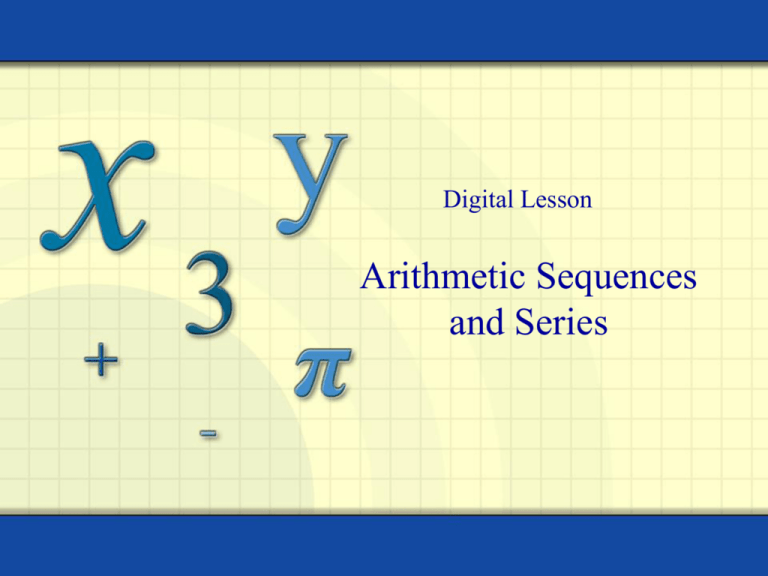
Digital Lesson
Arithmetic Sequences
and Series
An infinite sequence is a function whose domain
is the set of positive integers.
a1, a2, a3, a4, . . . , an, . . .
terms
The first three terms of the sequence an = 4n – 7 are
a1 = 4(1) – 7 = – 3
a2 = 4(2) – 7 = 1
finite sequence
a3 = 4(3) – 7 = 5.
Copyright © by Houghton Mifflin Company, Inc. All rights reserved.
2
A sequence is arithmetic if the differences
between consecutive terms are the same.
4, 9, 14, 19, 24, . . .
arithmetic sequence
9–4=5
14 – 9 = 5
19 – 14 = 5
The common difference, d, is 5.
24 – 19 = 5
Copyright © by Houghton Mifflin Company, Inc. All rights reserved.
3
Example: Find the first five terms of the sequence
and determine if it is arithmetic.
an = 1 + (n – 1)4
a1 = 1 + (1 – 1)4 = 1 + 0 = 1
a2 = 1 + (2 – 1)4 = 1 + 4 = 5
a3 = 1 + (3 – 1)4 = 1 + 8 = 9
d=4
a4 = 1 + (4 – 1)4 = 1 + 12 = 13
a5 = 1 + (5 – 1)4 = 1 + 16 = 17
This is an arithmetic sequence.
Copyright © by Houghton Mifflin Company, Inc. All rights reserved.
4
The nth term of an arithmetic sequence has the
form
an = dn + c
where d is the common difference and c = a1 – d.
a1 = 2
2, 8, 14, 20, 26, . . . .
c=2–6=–4
d=8–2=6
The nth term is 6n – 4.
Copyright © by Houghton Mifflin Company, Inc. All rights reserved.
5
Example: Find the formula for the nth term of an
arithmetic sequence whose common difference is 4
and whose first term is 15. Find the first five terms
of the sequence.
an = dn + c
a1 – d = 15 – 4 = 11
= 4n + 11
The first five terms are
a1 = 15
15, 19, 23, 27, 31.
d=4
Copyright © by Houghton Mifflin Company, Inc. All rights reserved.
6
The sum of a finite arithmetic sequence with n
terms is given by
S n n (a1 an).
2
5 + 10 + 15 + 20 + 25 + 30 + 35 + 40 + 45 + 50 = ?
n = 10
a1 = 5
a10 = 50
Sn 10 (5 50) 5(55) 275
2
Copyright © by Houghton Mifflin Company, Inc. All rights reserved.
7
The sum of the first n terms of an infinite sequence
is called the nth partial sum.
Sn n (a1 an)
2
Example: Find the 50th partial sum of the arithmetic
sequence – 6, – 2, 2, 6, . . .
a1 = – 6
d=4
an = dn + c = 4n – 10
c = a1 – d = – 10
a50 = 4(50) – 10 = 190
Sn 50 (6 190) 25(184) 4600
2
Copyright © by Houghton Mifflin Company, Inc. All rights reserved.
8
Graphing Utility: Find the first 5 terms of the arithmetic
sequence an = 4n + 11.
beginning
variable
value
end value
List Menu:
100
Graphing Utility: Find the sum 2n .
i 1
List Menu:
Copyright © by Houghton Mifflin Company, Inc. All rights reserved.
lower limit
upper
limit
9
The sum of the first n terms of a sequence is
represented by summation notation.
upper limit of summation
n
a a a
i 1
i
1
2
a3 a4
an
lower limit of summation
index of
summation
5
1 n (1 1) (1 2) (1 3) (1 4) (1 5)
i 1
2 3 4 5 6
20
Copyright © by Houghton Mifflin Company, Inc. All rights reserved.
10
Example: Find the partial sum.
100
2n 2(1) 2(2) 2(3)
246
i 1
a1
2(100)
200
a100
S100 n (a1 a100) 100 (2 200)
2
2
50(202) 10,100
Copyright © by Houghton Mifflin Company, Inc. All rights reserved.
11
Consider the infinite sequence a1, a2, a3, . . ., ai, . . ..
1. The sum of the first n terms of the sequence is called
a finite series or the partial sum of the sequence.
n
a1 + a2 + a3 + . . . + an ai
i 1
2. The sum of all the terms of the infinite sequence is
called an infinite series.
a1 + a2 + a3 + . . . + ai + . . . ai
i 1
Copyright © by Houghton Mifflin Company, Inc. All rights reserved.
12
i
Example: Find the fourth partial sum of 5 1 .
2
i 1
4
5 1 5 1 5 1 5 1
2
4
8
16
i
1
2
3
1 5 1 5 1 5 1 5 1
5
2
2
2
2
2
i1
4
555 5
2 4 8 16
40 20 10 5 75
16 16 16 16 16
Copyright © by Houghton Mifflin Company, Inc. All rights reserved.
13


